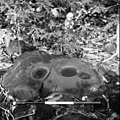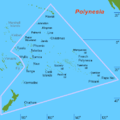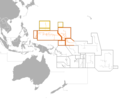Portal:Oceania
The Oceania PortalOceania (UK: /ˌoʊsiˈɑːniə, ˌoʊʃi-, -ˈeɪn-/ OH-s(h)ee-AH-nee-ə, -AY-, US: /ˌoʊʃiˈæniə, -ˈɑːn-/ ⓘ OH-shee-A(H)N-ee-ə) is a geographical region comprising Australasia, Melanesia, Micronesia, and Polynesia. Spanning the Eastern and Western Hemispheres, at the centre of the water hemisphere, Oceania is estimated to have a land area of about 9,000,000 square kilometres (3,500,000 sq mi) and a population of around 44.4 million as of 2022. When compared to the continents (which it is often compared to, not including Australia), Oceania is the smallest in land area and the second-least populated after Antarctica. Oceania has a diverse mix of economies from the highly developed and globally competitive financial markets of Australia, French Polynesia, Hawaii, New Caledonia, and New Zealand, which rank high in quality of life and Human Development Index, to the much less developed economies of Kiribati, Papua New Guinea, Tuvalu, Vanuatu, and Western New Guinea, while also including medium-sized economies of Pacific islands such as Fiji, Palau, and Tonga. The largest and most populous country in Oceania is Australia, and the largest city is Sydney. Puncak Jaya in Highland Papua, Indonesia, is the highest peak in Oceania at 4,884 m (16,024 ft). The arrival of European settlers in subsequent centuries resulted in a significant alteration in the social and political landscape of Oceania. The Pacific theatre saw major action during the First World War with the Japanese occupying many German territories. During the Second World War, Allied powers the United States, Philippines (a U.S. Commonwealth at the time) and Australia fought against Axis power Japan across various locations in Oceania. (Full article...) Selected geographic article -Lanai (Hawaiian: Lānaʻi, Hawaiian: [laːˈnɐʔi, naːˈnɐʔi], /ləˈnaɪ, lɑːˈnɑːi/ lə-NY, lah-NAH-ee, also US: /lɑːˈnaɪ, ləˈnɑːi/ lah-NY, lə-NAH-ee,) is the sixth-largest of the Hawaiian Islands and the smallest publicly accessible inhabited island in the chain. It is colloquially known as the Pineapple Island because of its past as an island-wide pineapple plantation. The island's only settlement of note is the small town of Lanai City. , the island is 98% owned by Larry Ellison, cofounder and chairman of Oracle Corporation; the remaining 2% is owned by the state of Hawaii or individual homeowners. Lanai is a roughly apostrophe-shaped island with a width of 18 miles (29 km) in the longest direction. The land area is 140.5 square miles (364 km2), making it the 43rd largest island in the United States. It is separated from the island of Molokaʻi by the Kalohi Channel to the north, and from Maui by the Auʻau Channel to the east. The United States Census Bureau defines Lanai as Census Tract 316 of Maui County. Its total population rose to 3,367 as of the 2020 United States census, up from 3,193 as of the 2000 census and 3,131 as of the 2010 census. As visible via satellite imagery, many of the island's landmarks are accessible only by dirt roads that require a four-wheel drive vehicle due to the lack of paved roadways. (Full article...)Related portalsSelected article -[[File:Rongorongo B-v Aruku-Kurenga (color) edit1.jpg|right|thumb|upright=2|[[Rongorongo text B|Tablet B Aruku kurenga]], verso. One of four texts which provided the Jaussen list, the first attempt at decipherment. Made of Pacific rosewood, mid-nineteenth century, Easter Island. (Collection of the SS.CC., Rome)]] There have been numerous attempts to decipher the rongorongo script of Easter Island since its discovery in the late nineteenth century. As with most undeciphered scripts, many of the proposals have been fanciful. Apart from a portion of one tablet which has been shown to deal with a lunar calendar, none of the texts are understood, and even the calendar cannot actually be read. The evidence is weak that rongorongo directly represents the Rapa Nui language – that is, that it is a true writing system – and oral accounts report that experts in one category of tablet were unable to read other tablets, suggesting either that rongorongo is not a unified system, or that it is proto-writing that requires the reader to already know the text. Assuming that rongorongo is writing, there are three serious obstacles to decipherment: the small number of remaining texts, comprising only 15,000 legible glyphs; the lack of context in which to interpret the texts, such as illustrations or parallel texts which can be read; and the fact that the modern Rapa Nui language is heavily mixed with Tahitian and is unlikely to closely reflect the language of the tablets—especially if they record a specialized register such as incantations—while the few remaining examples of the old language are heavily restricted in genre and may not correspond well to the tablets either. Since a proposal by Butinov and Knorozov in the 1950s, the majority of philologists, linguists and cultural historians have taken the line that rongorongo was not true writing but proto-writing, that is, an ideographic- and rebus-based mnemonic device, such as the Dongba script of the Nakhi people, which would in all likelihood make it impossible to decipher. This skepticism is justified not only by the failure of the numerous attempts at decipherment, but by the extreme rarity of independent writing systems around the world. Of those who have attempted to decipher rongorongo as a true writing system, the vast majority have assumed it was logographic, a few that it was syllabic or mixed. Statistically, it appears to have been compatible with neither a pure logography nor a pure syllabary. The topic of the texts is unknown; various investigators have speculated they cover genealogy, navigation, astronomy, or agriculture. Oral history suggests that only a small elite were ever literate, and that the tablets were considered sacred.[page needed] (Full article...)Did you know -
General images -The following are images from various Oceania-related articles on Wikipedia.
TopicsSubcategoriesThings you can doAssociated WikimediaThe following Wikimedia Foundation sister projects provide more on this subject:
In other languagesWikipedia in other languages used in Oceania:
More portals |







































































